Evaluating Leadership & Management's Role in Operations Management
VerifiedAdded on 2024/06/07
|29
|6447
|373
Report
AI Summary
This report provides a comprehensive analysis of the impact of leadership and management on operations management, with a specific focus on Toyota Plc. It defines and compares the roles and characteristics of leaders and managers, differentiating between their functions by applying various theories and concepts such as situational leadership, systems leadership, and contingency theory. The report examines examples of how these roles apply in different situational contexts, assessing the strengths and weaknesses of different approaches within the work environment. It also explains key approaches to operations management, emphasizing the importance of operations management in achieving business objectives and evaluating how leaders and managers can improve efficiencies to successfully meet these objectives. Furthermore, the report assesses the factors within the business environment that impact operational management and decision-making, analyzing how these factors affect the wider business environment and community, ultimately providing a critical evaluation of the application of operations management in various contexts.
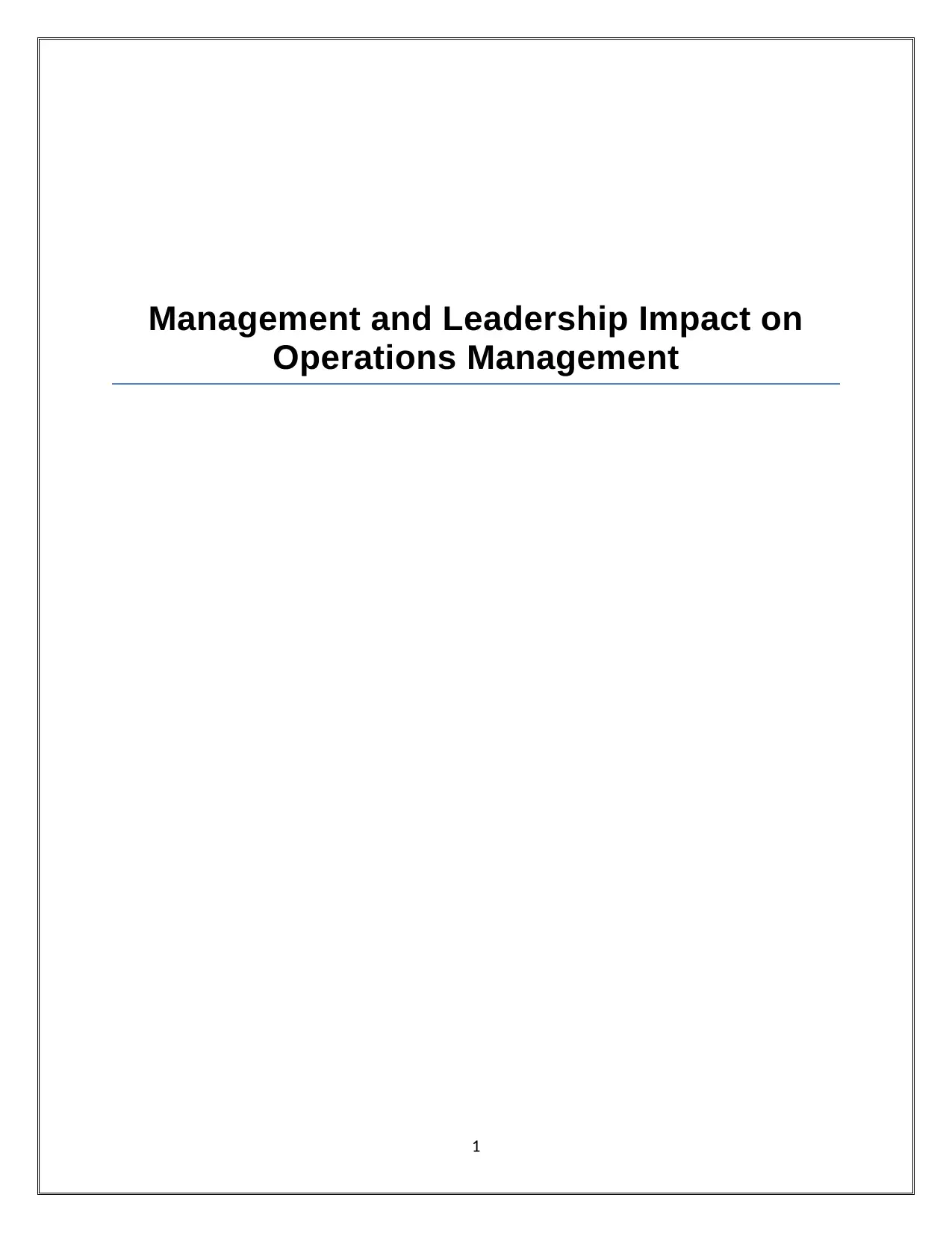
Management and Leadership Impact on
Operations Management
1
Operations Management
1
Paraphrase This Document
Need a fresh take? Get an instant paraphrase of this document with our AI Paraphraser
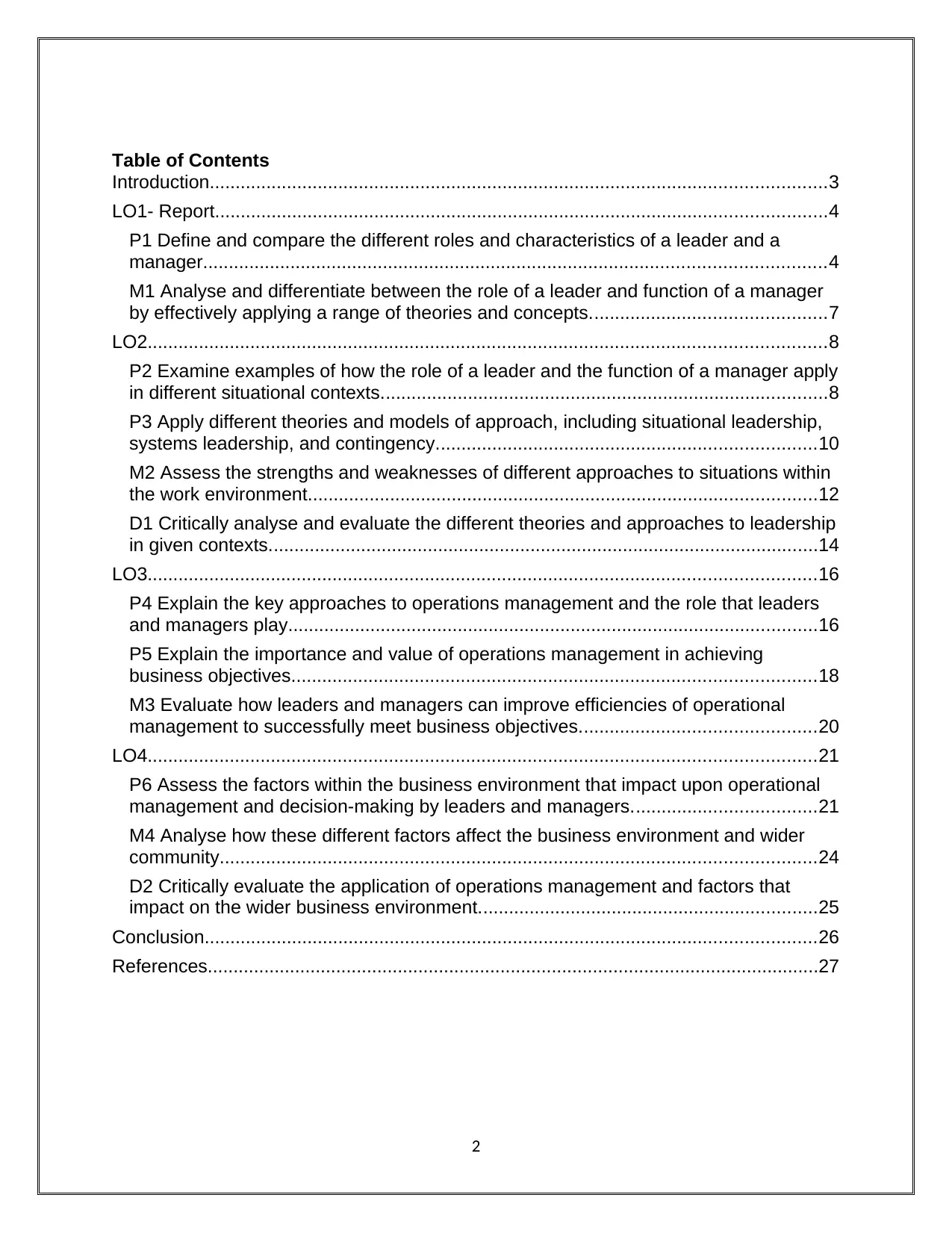
Table of Contents
Introduction........................................................................................................................3
LO1- Report.......................................................................................................................4
P1 Define and compare the different roles and characteristics of a leader and a
manager.........................................................................................................................4
M1 Analyse and differentiate between the role of a leader and function of a manager
by effectively applying a range of theories and concepts..............................................7
LO2....................................................................................................................................8
P2 Examine examples of how the role of a leader and the function of a manager apply
in different situational contexts.......................................................................................8
P3 Apply different theories and models of approach, including situational leadership,
systems leadership, and contingency..........................................................................10
M2 Assess the strengths and weaknesses of different approaches to situations within
the work environment...................................................................................................12
D1 Critically analyse and evaluate the different theories and approaches to leadership
in given contexts...........................................................................................................14
LO3..................................................................................................................................16
P4 Explain the key approaches to operations management and the role that leaders
and managers play.......................................................................................................16
P5 Explain the importance and value of operations management in achieving
business objectives......................................................................................................18
M3 Evaluate how leaders and managers can improve efficiencies of operational
management to successfully meet business objectives..............................................20
LO4..................................................................................................................................21
P6 Assess the factors within the business environment that impact upon operational
management and decision-making by leaders and managers....................................21
M4 Analyse how these different factors affect the business environment and wider
community....................................................................................................................24
D2 Critically evaluate the application of operations management and factors that
impact on the wider business environment..................................................................25
Conclusion.......................................................................................................................26
References.......................................................................................................................27
2
Introduction........................................................................................................................3
LO1- Report.......................................................................................................................4
P1 Define and compare the different roles and characteristics of a leader and a
manager.........................................................................................................................4
M1 Analyse and differentiate between the role of a leader and function of a manager
by effectively applying a range of theories and concepts..............................................7
LO2....................................................................................................................................8
P2 Examine examples of how the role of a leader and the function of a manager apply
in different situational contexts.......................................................................................8
P3 Apply different theories and models of approach, including situational leadership,
systems leadership, and contingency..........................................................................10
M2 Assess the strengths and weaknesses of different approaches to situations within
the work environment...................................................................................................12
D1 Critically analyse and evaluate the different theories and approaches to leadership
in given contexts...........................................................................................................14
LO3..................................................................................................................................16
P4 Explain the key approaches to operations management and the role that leaders
and managers play.......................................................................................................16
P5 Explain the importance and value of operations management in achieving
business objectives......................................................................................................18
M3 Evaluate how leaders and managers can improve efficiencies of operational
management to successfully meet business objectives..............................................20
LO4..................................................................................................................................21
P6 Assess the factors within the business environment that impact upon operational
management and decision-making by leaders and managers....................................21
M4 Analyse how these different factors affect the business environment and wider
community....................................................................................................................24
D2 Critically evaluate the application of operations management and factors that
impact on the wider business environment..................................................................25
Conclusion.......................................................................................................................26
References.......................................................................................................................27
2
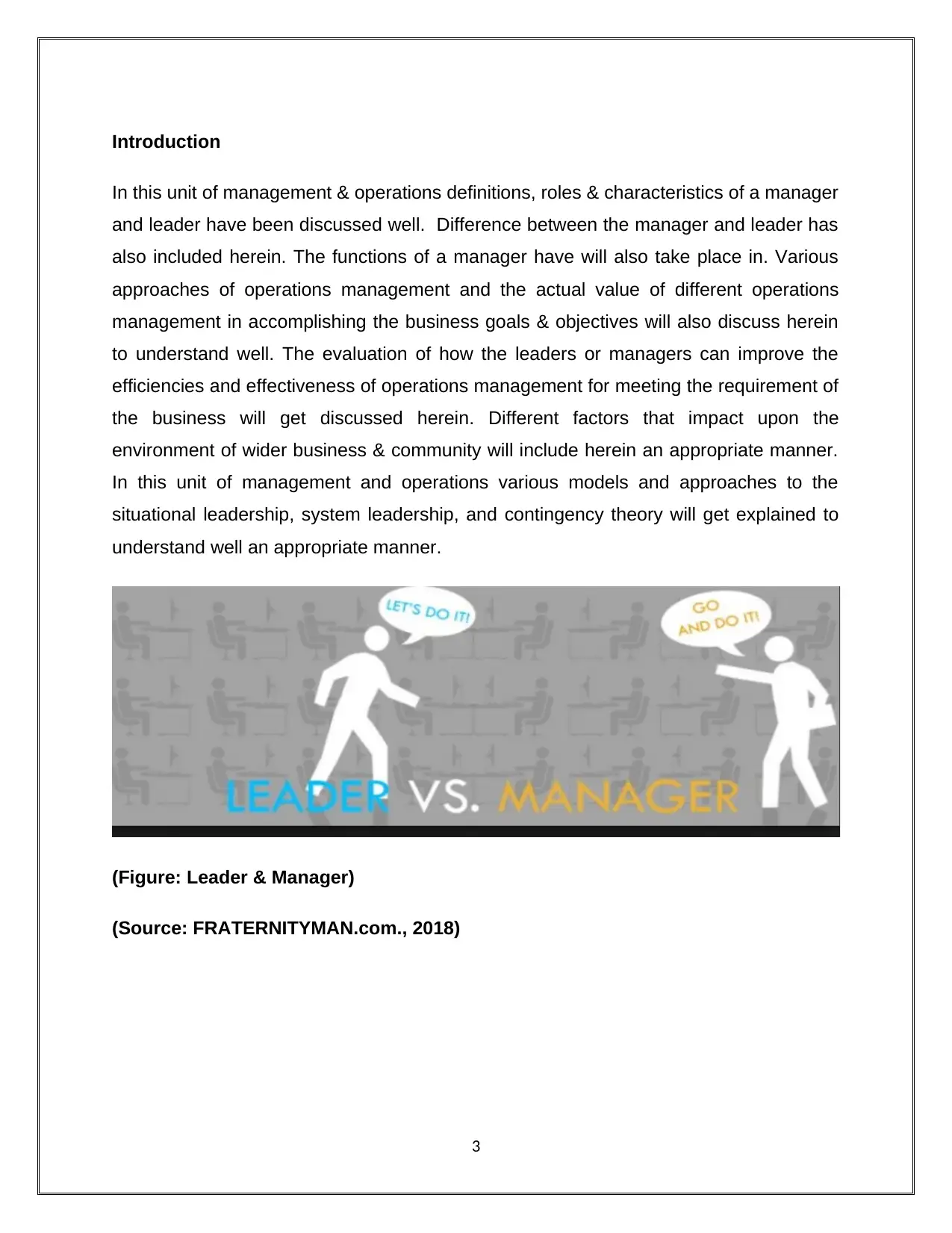
Introduction
In this unit of management & operations definitions, roles & characteristics of a manager
and leader have been discussed well. Difference between the manager and leader has
also included herein. The functions of a manager have will also take place in. Various
approaches of operations management and the actual value of different operations
management in accomplishing the business goals & objectives will also discuss herein
to understand well. The evaluation of how the leaders or managers can improve the
efficiencies and effectiveness of operations management for meeting the requirement of
the business will get discussed herein. Different factors that impact upon the
environment of wider business & community will include herein an appropriate manner.
In this unit of management and operations various models and approaches to the
situational leadership, system leadership, and contingency theory will get explained to
understand well an appropriate manner.
(Figure: Leader & Manager)
(Source: FRATERNITYMAN.com., 2018)
3
In this unit of management & operations definitions, roles & characteristics of a manager
and leader have been discussed well. Difference between the manager and leader has
also included herein. The functions of a manager have will also take place in. Various
approaches of operations management and the actual value of different operations
management in accomplishing the business goals & objectives will also discuss herein
to understand well. The evaluation of how the leaders or managers can improve the
efficiencies and effectiveness of operations management for meeting the requirement of
the business will get discussed herein. Different factors that impact upon the
environment of wider business & community will include herein an appropriate manner.
In this unit of management and operations various models and approaches to the
situational leadership, system leadership, and contingency theory will get explained to
understand well an appropriate manner.
(Figure: Leader & Manager)
(Source: FRATERNITYMAN.com., 2018)
3
⊘ This is a preview!⊘
Do you want full access?
Subscribe today to unlock all pages.

Trusted by 1+ million students worldwide
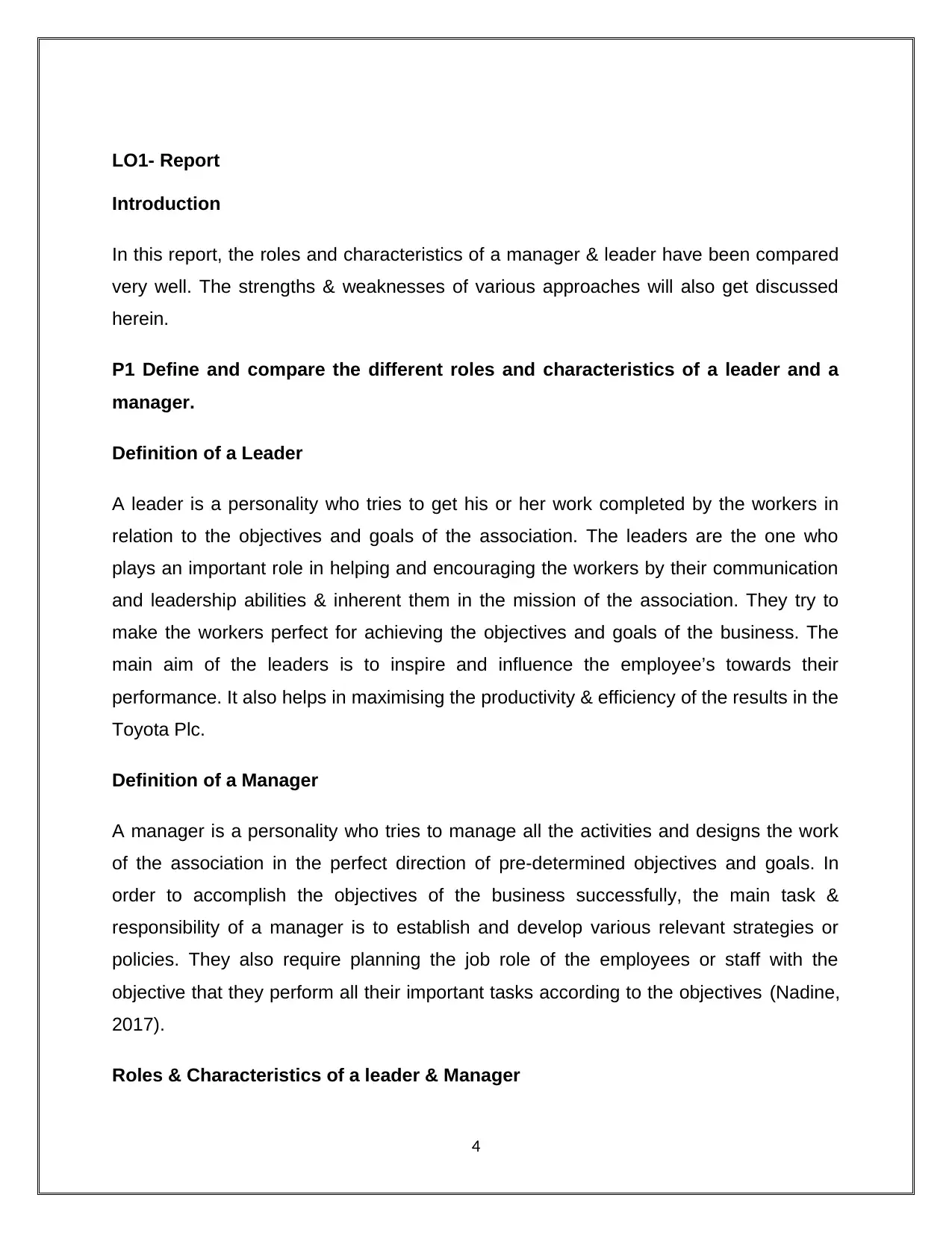
LO1- Report
Introduction
In this report, the roles and characteristics of a manager & leader have been compared
very well. The strengths & weaknesses of various approaches will also get discussed
herein.
P1 Define and compare the different roles and characteristics of a leader and a
manager.
Definition of a Leader
A leader is a personality who tries to get his or her work completed by the workers in
relation to the objectives and goals of the association. The leaders are the one who
plays an important role in helping and encouraging the workers by their communication
and leadership abilities & inherent them in the mission of the association. They try to
make the workers perfect for achieving the objectives and goals of the business. The
main aim of the leaders is to inspire and influence the employee’s towards their
performance. It also helps in maximising the productivity & efficiency of the results in the
Toyota Plc.
Definition of a Manager
A manager is a personality who tries to manage all the activities and designs the work
of the association in the perfect direction of pre-determined objectives and goals. In
order to accomplish the objectives of the business successfully, the main task &
responsibility of a manager is to establish and develop various relevant strategies or
policies. They also require planning the job role of the employees or staff with the
objective that they perform all their important tasks according to the objectives (Nadine,
2017).
Roles & Characteristics of a leader & Manager
4
Introduction
In this report, the roles and characteristics of a manager & leader have been compared
very well. The strengths & weaknesses of various approaches will also get discussed
herein.
P1 Define and compare the different roles and characteristics of a leader and a
manager.
Definition of a Leader
A leader is a personality who tries to get his or her work completed by the workers in
relation to the objectives and goals of the association. The leaders are the one who
plays an important role in helping and encouraging the workers by their communication
and leadership abilities & inherent them in the mission of the association. They try to
make the workers perfect for achieving the objectives and goals of the business. The
main aim of the leaders is to inspire and influence the employee’s towards their
performance. It also helps in maximising the productivity & efficiency of the results in the
Toyota Plc.
Definition of a Manager
A manager is a personality who tries to manage all the activities and designs the work
of the association in the perfect direction of pre-determined objectives and goals. In
order to accomplish the objectives of the business successfully, the main task &
responsibility of a manager is to establish and develop various relevant strategies or
policies. They also require planning the job role of the employees or staff with the
objective that they perform all their important tasks according to the objectives (Nadine,
2017).
Roles & Characteristics of a leader & Manager
4
Paraphrase This Document
Need a fresh take? Get an instant paraphrase of this document with our AI Paraphraser
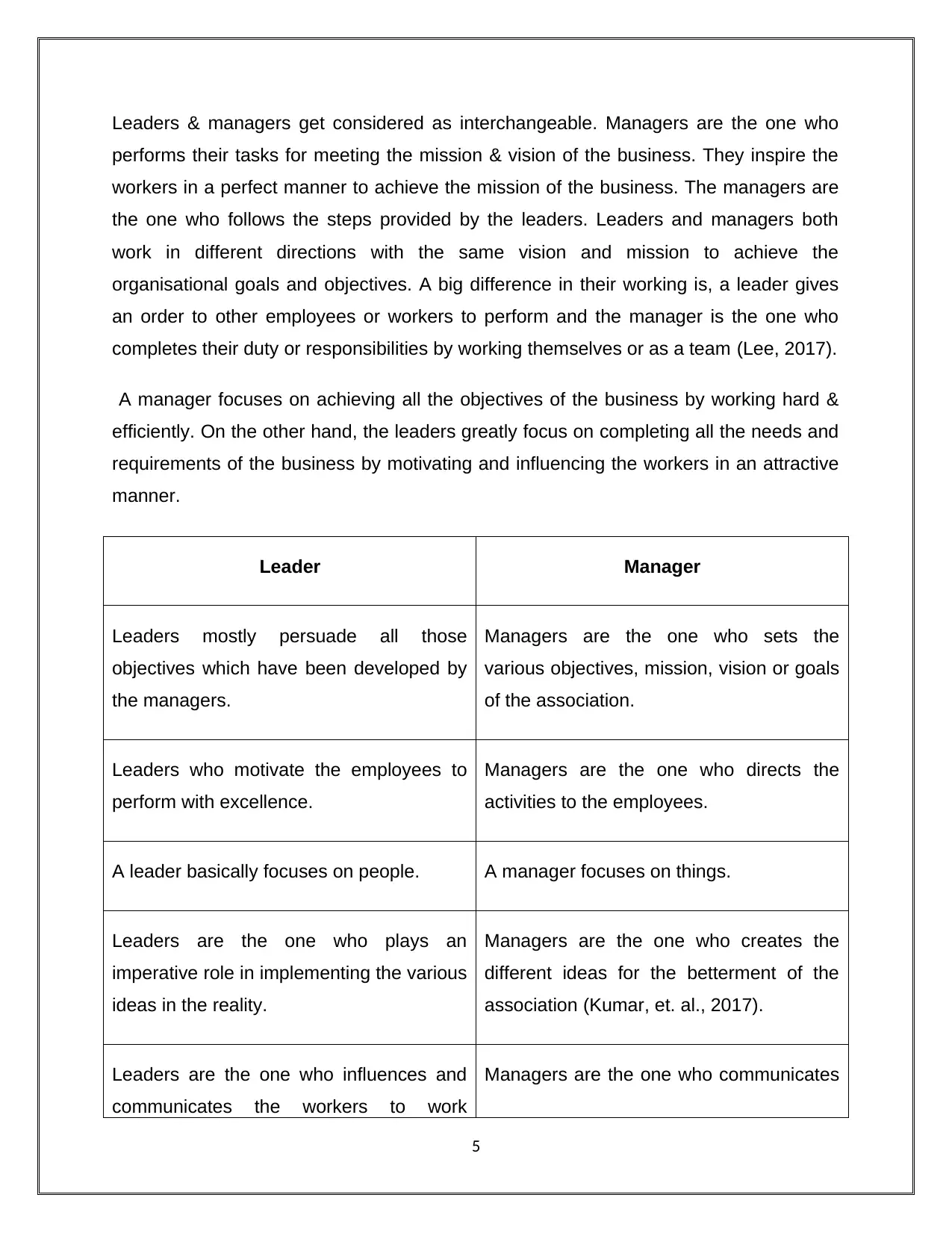
Leaders & managers get considered as interchangeable. Managers are the one who
performs their tasks for meeting the mission & vision of the business. They inspire the
workers in a perfect manner to achieve the mission of the business. The managers are
the one who follows the steps provided by the leaders. Leaders and managers both
work in different directions with the same vision and mission to achieve the
organisational goals and objectives. A big difference in their working is, a leader gives
an order to other employees or workers to perform and the manager is the one who
completes their duty or responsibilities by working themselves or as a team (Lee, 2017).
A manager focuses on achieving all the objectives of the business by working hard &
efficiently. On the other hand, the leaders greatly focus on completing all the needs and
requirements of the business by motivating and influencing the workers in an attractive
manner.
Leader Manager
Leaders mostly persuade all those
objectives which have been developed by
the managers.
Managers are the one who sets the
various objectives, mission, vision or goals
of the association.
Leaders who motivate the employees to
perform with excellence.
Managers are the one who directs the
activities to the employees.
A leader basically focuses on people. A manager focuses on things.
Leaders are the one who plays an
imperative role in implementing the various
ideas in the reality.
Managers are the one who creates the
different ideas for the betterment of the
association (Kumar, et. al., 2017).
Leaders are the one who influences and
communicates the workers to work
Managers are the one who communicates
5
performs their tasks for meeting the mission & vision of the business. They inspire the
workers in a perfect manner to achieve the mission of the business. The managers are
the one who follows the steps provided by the leaders. Leaders and managers both
work in different directions with the same vision and mission to achieve the
organisational goals and objectives. A big difference in their working is, a leader gives
an order to other employees or workers to perform and the manager is the one who
completes their duty or responsibilities by working themselves or as a team (Lee, 2017).
A manager focuses on achieving all the objectives of the business by working hard &
efficiently. On the other hand, the leaders greatly focus on completing all the needs and
requirements of the business by motivating and influencing the workers in an attractive
manner.
Leader Manager
Leaders mostly persuade all those
objectives which have been developed by
the managers.
Managers are the one who sets the
various objectives, mission, vision or goals
of the association.
Leaders who motivate the employees to
perform with excellence.
Managers are the one who directs the
activities to the employees.
A leader basically focuses on people. A manager focuses on things.
Leaders are the one who plays an
imperative role in implementing the various
ideas in the reality.
Managers are the one who creates the
different ideas for the betterment of the
association (Kumar, et. al., 2017).
Leaders are the one who influences and
communicates the workers to work
Managers are the one who communicates
5
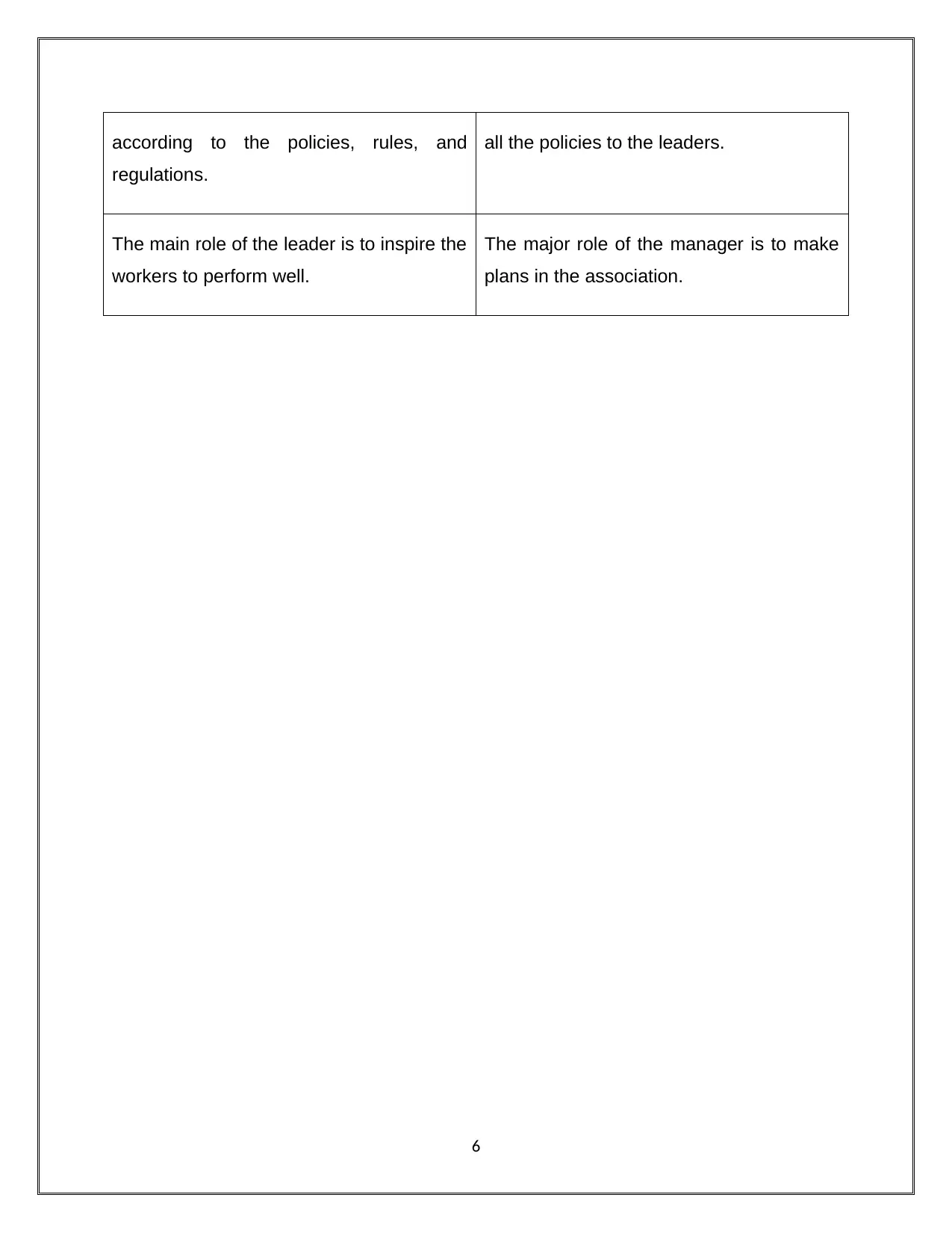
according to the policies, rules, and
regulations.
all the policies to the leaders.
The main role of the leader is to inspire the
workers to perform well.
The major role of the manager is to make
plans in the association.
6
regulations.
all the policies to the leaders.
The main role of the leader is to inspire the
workers to perform well.
The major role of the manager is to make
plans in the association.
6
⊘ This is a preview!⊘
Do you want full access?
Subscribe today to unlock all pages.

Trusted by 1+ million students worldwide
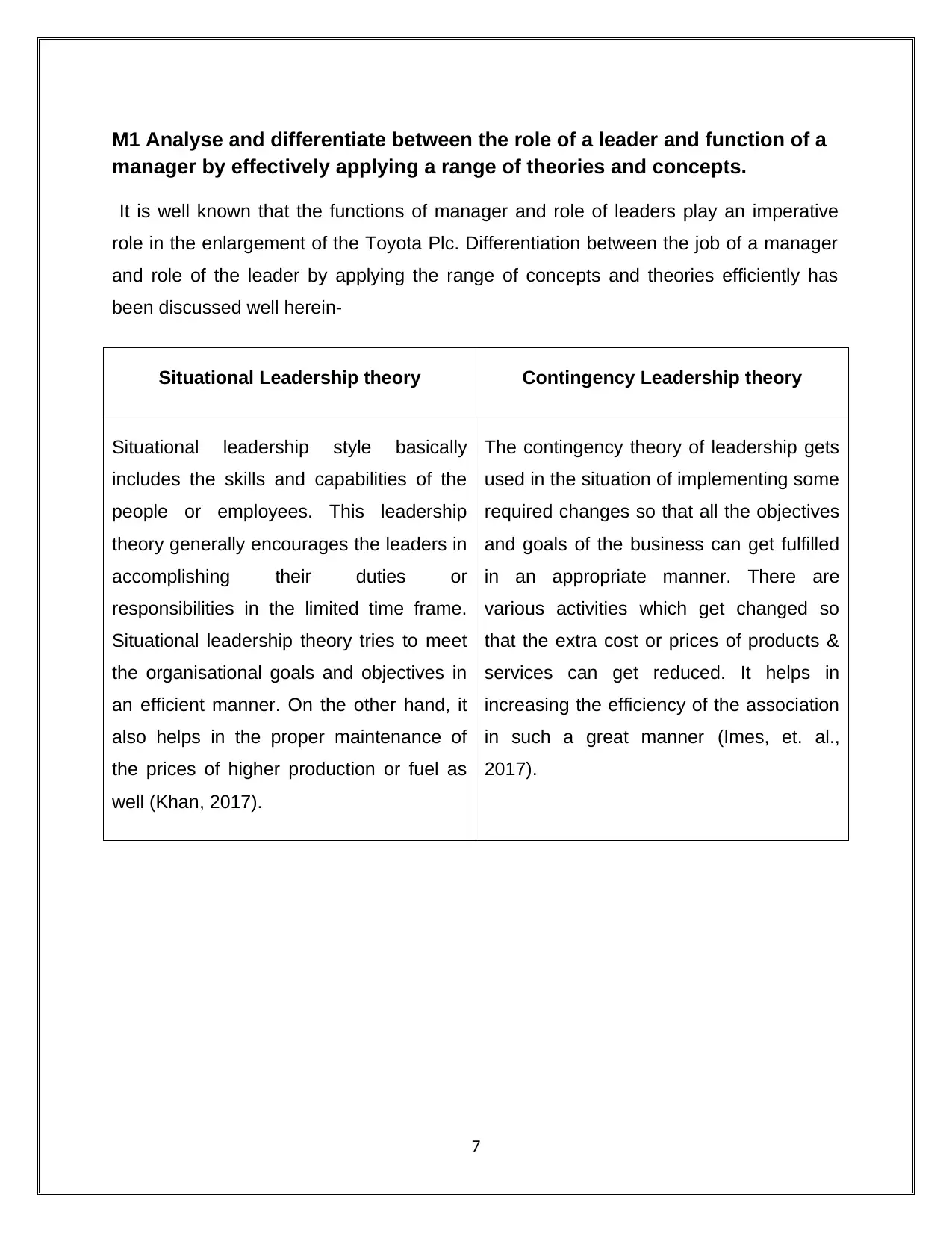
M1 Analyse and differentiate between the role of a leader and function of a
manager by effectively applying a range of theories and concepts.
It is well known that the functions of manager and role of leaders play an imperative
role in the enlargement of the Toyota Plc. Differentiation between the job of a manager
and role of the leader by applying the range of concepts and theories efficiently has
been discussed well herein-
Situational Leadership theory Contingency Leadership theory
Situational leadership style basically
includes the skills and capabilities of the
people or employees. This leadership
theory generally encourages the leaders in
accomplishing their duties or
responsibilities in the limited time frame.
Situational leadership theory tries to meet
the organisational goals and objectives in
an efficient manner. On the other hand, it
also helps in the proper maintenance of
the prices of higher production or fuel as
well (Khan, 2017).
The contingency theory of leadership gets
used in the situation of implementing some
required changes so that all the objectives
and goals of the business can get fulfilled
in an appropriate manner. There are
various activities which get changed so
that the extra cost or prices of products &
services can get reduced. It helps in
increasing the efficiency of the association
in such a great manner (Imes, et. al.,
2017).
7
manager by effectively applying a range of theories and concepts.
It is well known that the functions of manager and role of leaders play an imperative
role in the enlargement of the Toyota Plc. Differentiation between the job of a manager
and role of the leader by applying the range of concepts and theories efficiently has
been discussed well herein-
Situational Leadership theory Contingency Leadership theory
Situational leadership style basically
includes the skills and capabilities of the
people or employees. This leadership
theory generally encourages the leaders in
accomplishing their duties or
responsibilities in the limited time frame.
Situational leadership theory tries to meet
the organisational goals and objectives in
an efficient manner. On the other hand, it
also helps in the proper maintenance of
the prices of higher production or fuel as
well (Khan, 2017).
The contingency theory of leadership gets
used in the situation of implementing some
required changes so that all the objectives
and goals of the business can get fulfilled
in an appropriate manner. There are
various activities which get changed so
that the extra cost or prices of products &
services can get reduced. It helps in
increasing the efficiency of the association
in such a great manner (Imes, et. al.,
2017).
7
Paraphrase This Document
Need a fresh take? Get an instant paraphrase of this document with our AI Paraphraser
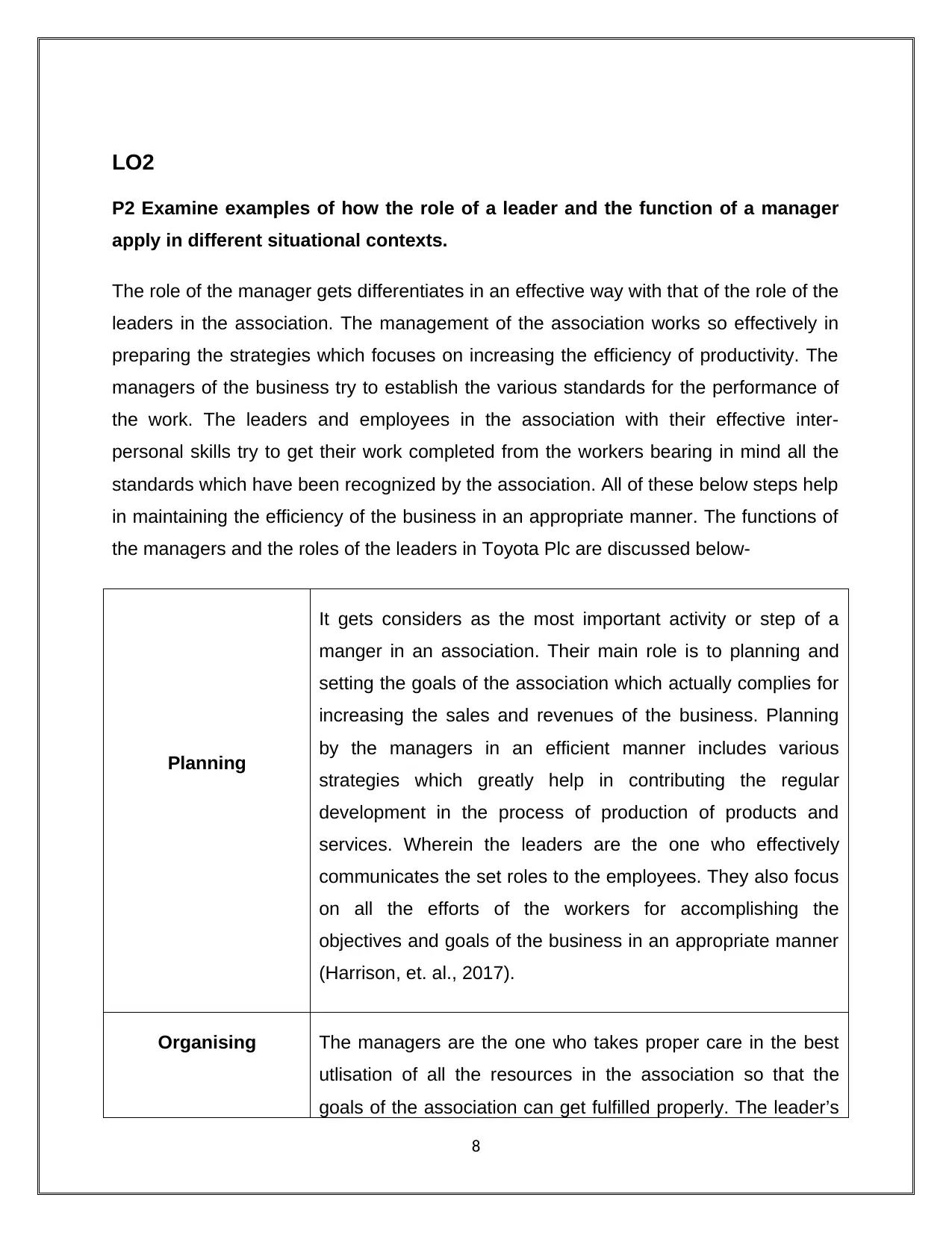
LO2
P2 Examine examples of how the role of a leader and the function of a manager
apply in different situational contexts.
The role of the manager gets differentiates in an effective way with that of the role of the
leaders in the association. The management of the association works so effectively in
preparing the strategies which focuses on increasing the efficiency of productivity. The
managers of the business try to establish the various standards for the performance of
the work. The leaders and employees in the association with their effective inter-
personal skills try to get their work completed from the workers bearing in mind all the
standards which have been recognized by the association. All of these below steps help
in maintaining the efficiency of the business in an appropriate manner. The functions of
the managers and the roles of the leaders in Toyota Plc are discussed below-
Planning
It gets considers as the most important activity or step of a
manger in an association. Their main role is to planning and
setting the goals of the association which actually complies for
increasing the sales and revenues of the business. Planning
by the managers in an efficient manner includes various
strategies which greatly help in contributing the regular
development in the process of production of products and
services. Wherein the leaders are the one who effectively
communicates the set roles to the employees. They also focus
on all the efforts of the workers for accomplishing the
objectives and goals of the business in an appropriate manner
(Harrison, et. al., 2017).
Organising The managers are the one who takes proper care in the best
utlisation of all the resources in the association so that the
goals of the association can get fulfilled properly. The leader’s
8
P2 Examine examples of how the role of a leader and the function of a manager
apply in different situational contexts.
The role of the manager gets differentiates in an effective way with that of the role of the
leaders in the association. The management of the association works so effectively in
preparing the strategies which focuses on increasing the efficiency of productivity. The
managers of the business try to establish the various standards for the performance of
the work. The leaders and employees in the association with their effective inter-
personal skills try to get their work completed from the workers bearing in mind all the
standards which have been recognized by the association. All of these below steps help
in maintaining the efficiency of the business in an appropriate manner. The functions of
the managers and the roles of the leaders in Toyota Plc are discussed below-
Planning
It gets considers as the most important activity or step of a
manger in an association. Their main role is to planning and
setting the goals of the association which actually complies for
increasing the sales and revenues of the business. Planning
by the managers in an efficient manner includes various
strategies which greatly help in contributing the regular
development in the process of production of products and
services. Wherein the leaders are the one who effectively
communicates the set roles to the employees. They also focus
on all the efforts of the workers for accomplishing the
objectives and goals of the business in an appropriate manner
(Harrison, et. al., 2017).
Organising The managers are the one who takes proper care in the best
utlisation of all the resources in the association so that the
goals of the association can get fulfilled properly. The leader’s
8
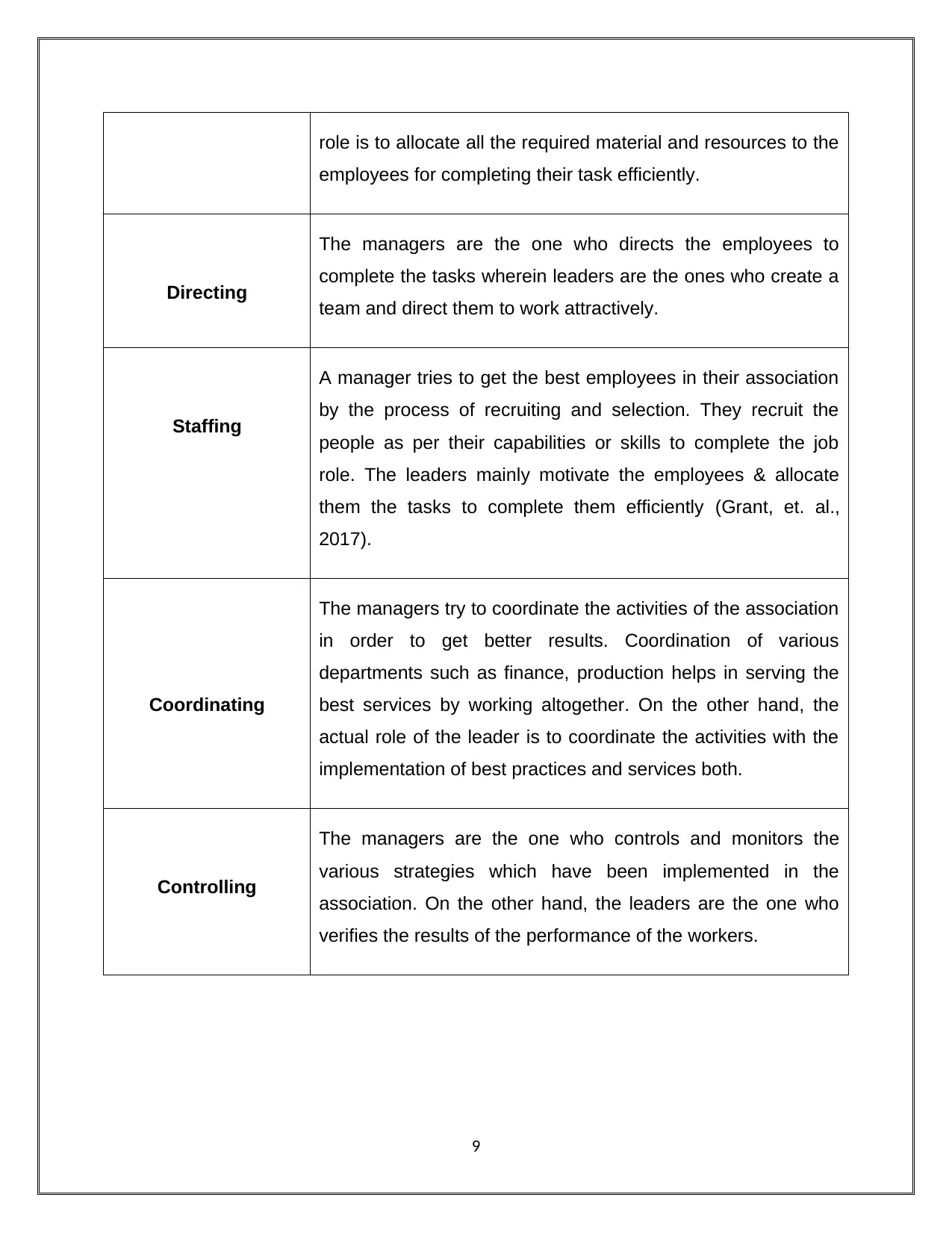
role is to allocate all the required material and resources to the
employees for completing their task efficiently.
Directing
The managers are the one who directs the employees to
complete the tasks wherein leaders are the ones who create a
team and direct them to work attractively.
Staffing
A manager tries to get the best employees in their association
by the process of recruiting and selection. They recruit the
people as per their capabilities or skills to complete the job
role. The leaders mainly motivate the employees & allocate
them the tasks to complete them efficiently (Grant, et. al.,
2017).
Coordinating
The managers try to coordinate the activities of the association
in order to get better results. Coordination of various
departments such as finance, production helps in serving the
best services by working altogether. On the other hand, the
actual role of the leader is to coordinate the activities with the
implementation of best practices and services both.
Controlling
The managers are the one who controls and monitors the
various strategies which have been implemented in the
association. On the other hand, the leaders are the one who
verifies the results of the performance of the workers.
9
employees for completing their task efficiently.
Directing
The managers are the one who directs the employees to
complete the tasks wherein leaders are the ones who create a
team and direct them to work attractively.
Staffing
A manager tries to get the best employees in their association
by the process of recruiting and selection. They recruit the
people as per their capabilities or skills to complete the job
role. The leaders mainly motivate the employees & allocate
them the tasks to complete them efficiently (Grant, et. al.,
2017).
Coordinating
The managers try to coordinate the activities of the association
in order to get better results. Coordination of various
departments such as finance, production helps in serving the
best services by working altogether. On the other hand, the
actual role of the leader is to coordinate the activities with the
implementation of best practices and services both.
Controlling
The managers are the one who controls and monitors the
various strategies which have been implemented in the
association. On the other hand, the leaders are the one who
verifies the results of the performance of the workers.
9
⊘ This is a preview!⊘
Do you want full access?
Subscribe today to unlock all pages.

Trusted by 1+ million students worldwide
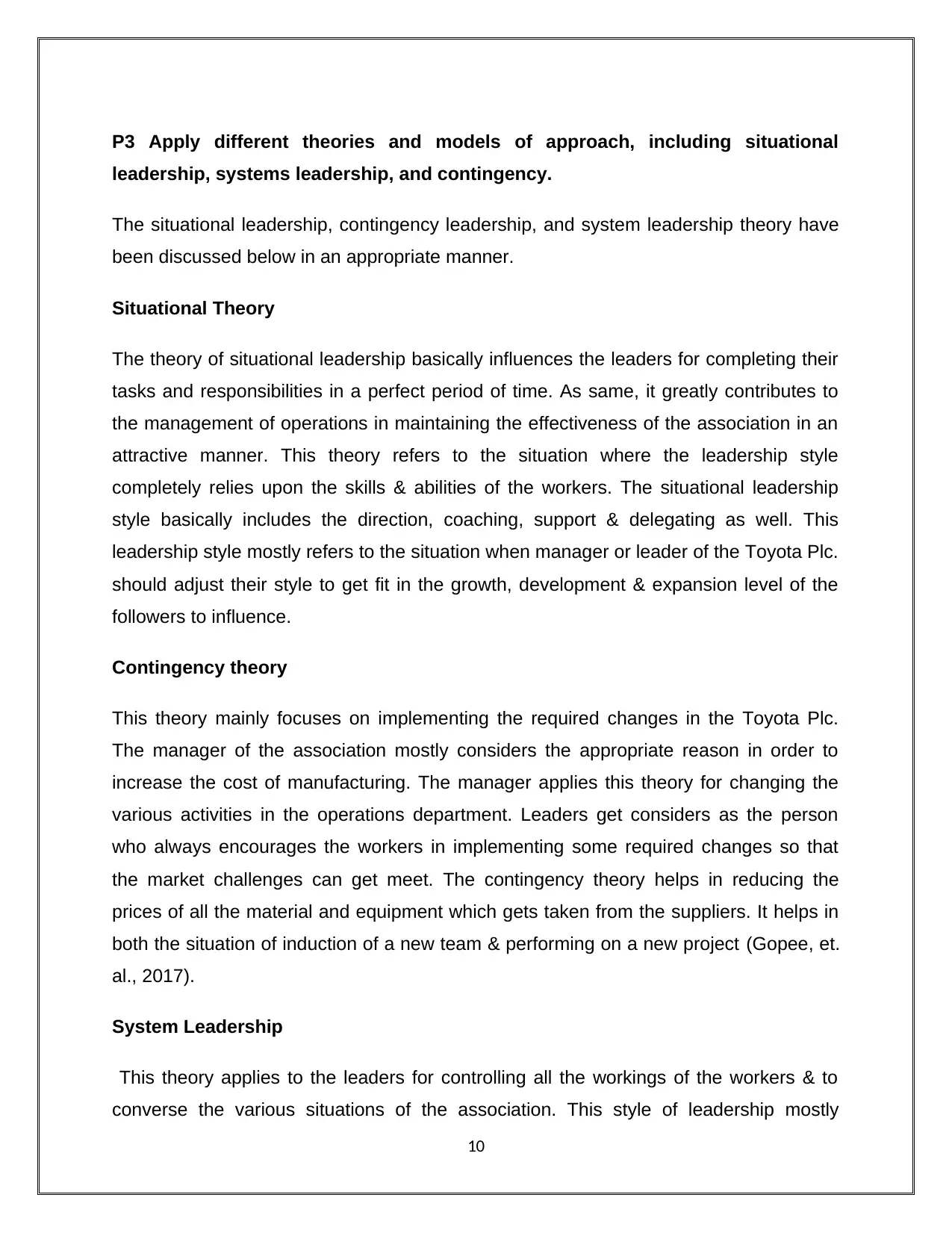
P3 Apply different theories and models of approach, including situational
leadership, systems leadership, and contingency.
The situational leadership, contingency leadership, and system leadership theory have
been discussed below in an appropriate manner.
Situational Theory
The theory of situational leadership basically influences the leaders for completing their
tasks and responsibilities in a perfect period of time. As same, it greatly contributes to
the management of operations in maintaining the effectiveness of the association in an
attractive manner. This theory refers to the situation where the leadership style
completely relies upon the skills & abilities of the workers. The situational leadership
style basically includes the direction, coaching, support & delegating as well. This
leadership style mostly refers to the situation when manager or leader of the Toyota Plc.
should adjust their style to get fit in the growth, development & expansion level of the
followers to influence.
Contingency theory
This theory mainly focuses on implementing the required changes in the Toyota Plc.
The manager of the association mostly considers the appropriate reason in order to
increase the cost of manufacturing. The manager applies this theory for changing the
various activities in the operations department. Leaders get considers as the person
who always encourages the workers in implementing some required changes so that
the market challenges can get meet. The contingency theory helps in reducing the
prices of all the material and equipment which gets taken from the suppliers. It helps in
both the situation of induction of a new team & performing on a new project (Gopee, et.
al., 2017).
System Leadership
This theory applies to the leaders for controlling all the workings of the workers & to
converse the various situations of the association. This style of leadership mostly
10
leadership, systems leadership, and contingency.
The situational leadership, contingency leadership, and system leadership theory have
been discussed below in an appropriate manner.
Situational Theory
The theory of situational leadership basically influences the leaders for completing their
tasks and responsibilities in a perfect period of time. As same, it greatly contributes to
the management of operations in maintaining the effectiveness of the association in an
attractive manner. This theory refers to the situation where the leadership style
completely relies upon the skills & abilities of the workers. The situational leadership
style basically includes the direction, coaching, support & delegating as well. This
leadership style mostly refers to the situation when manager or leader of the Toyota Plc.
should adjust their style to get fit in the growth, development & expansion level of the
followers to influence.
Contingency theory
This theory mainly focuses on implementing the required changes in the Toyota Plc.
The manager of the association mostly considers the appropriate reason in order to
increase the cost of manufacturing. The manager applies this theory for changing the
various activities in the operations department. Leaders get considers as the person
who always encourages the workers in implementing some required changes so that
the market challenges can get meet. The contingency theory helps in reducing the
prices of all the material and equipment which gets taken from the suppliers. It helps in
both the situation of induction of a new team & performing on a new project (Gopee, et.
al., 2017).
System Leadership
This theory applies to the leaders for controlling all the workings of the workers & to
converse the various situations of the association. This style of leadership mostly
10
Paraphrase This Document
Need a fresh take? Get an instant paraphrase of this document with our AI Paraphraser
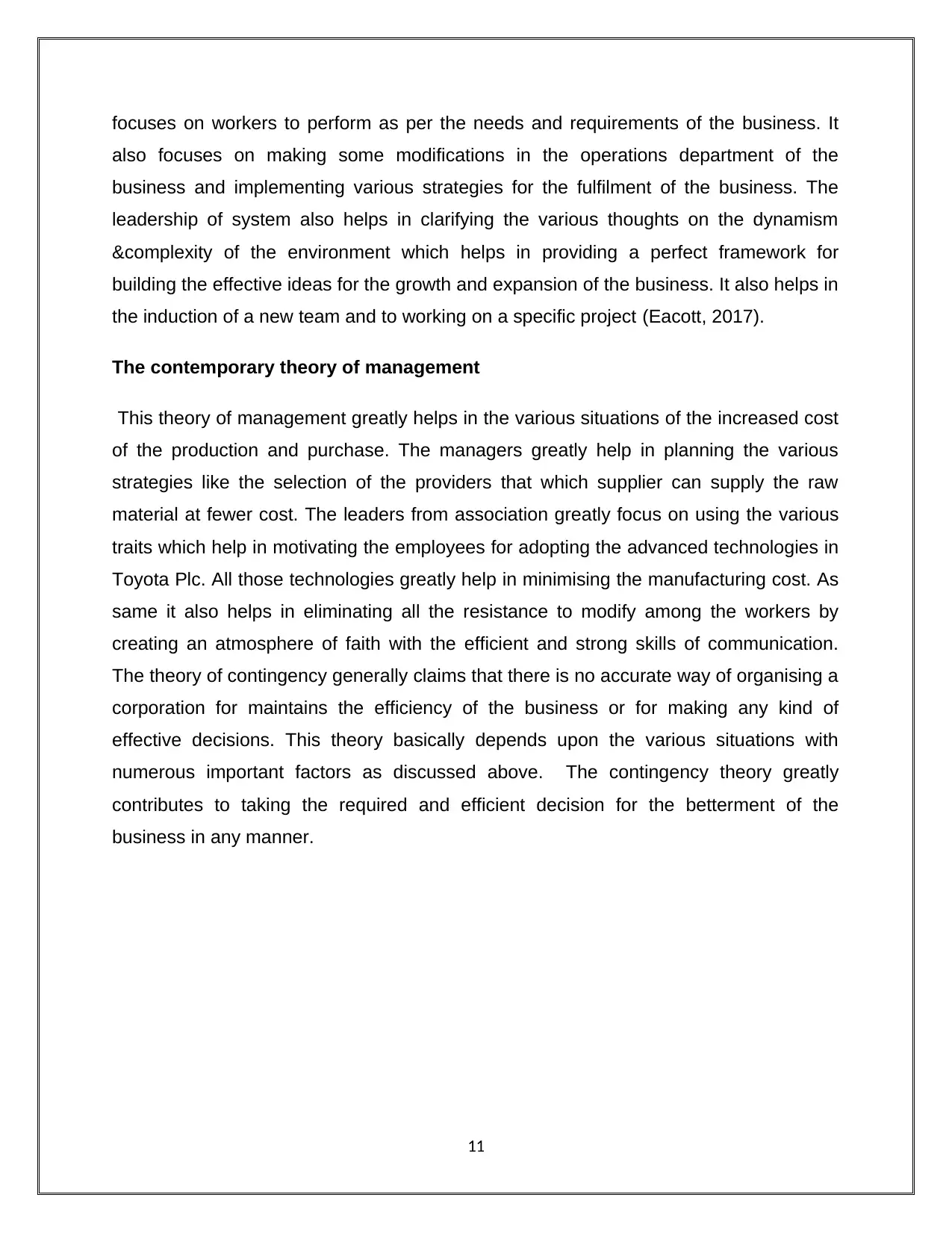
focuses on workers to perform as per the needs and requirements of the business. It
also focuses on making some modifications in the operations department of the
business and implementing various strategies for the fulfilment of the business. The
leadership of system also helps in clarifying the various thoughts on the dynamism
&complexity of the environment which helps in providing a perfect framework for
building the effective ideas for the growth and expansion of the business. It also helps in
the induction of a new team and to working on a specific project (Eacott, 2017).
The contemporary theory of management
This theory of management greatly helps in the various situations of the increased cost
of the production and purchase. The managers greatly help in planning the various
strategies like the selection of the providers that which supplier can supply the raw
material at fewer cost. The leaders from association greatly focus on using the various
traits which help in motivating the employees for adopting the advanced technologies in
Toyota Plc. All those technologies greatly help in minimising the manufacturing cost. As
same it also helps in eliminating all the resistance to modify among the workers by
creating an atmosphere of faith with the efficient and strong skills of communication.
The theory of contingency generally claims that there is no accurate way of organising a
corporation for maintains the efficiency of the business or for making any kind of
effective decisions. This theory basically depends upon the various situations with
numerous important factors as discussed above. The contingency theory greatly
contributes to taking the required and efficient decision for the betterment of the
business in any manner.
11
also focuses on making some modifications in the operations department of the
business and implementing various strategies for the fulfilment of the business. The
leadership of system also helps in clarifying the various thoughts on the dynamism
&complexity of the environment which helps in providing a perfect framework for
building the effective ideas for the growth and expansion of the business. It also helps in
the induction of a new team and to working on a specific project (Eacott, 2017).
The contemporary theory of management
This theory of management greatly helps in the various situations of the increased cost
of the production and purchase. The managers greatly help in planning the various
strategies like the selection of the providers that which supplier can supply the raw
material at fewer cost. The leaders from association greatly focus on using the various
traits which help in motivating the employees for adopting the advanced technologies in
Toyota Plc. All those technologies greatly help in minimising the manufacturing cost. As
same it also helps in eliminating all the resistance to modify among the workers by
creating an atmosphere of faith with the efficient and strong skills of communication.
The theory of contingency generally claims that there is no accurate way of organising a
corporation for maintains the efficiency of the business or for making any kind of
effective decisions. This theory basically depends upon the various situations with
numerous important factors as discussed above. The contingency theory greatly
contributes to taking the required and efficient decision for the betterment of the
business in any manner.
11
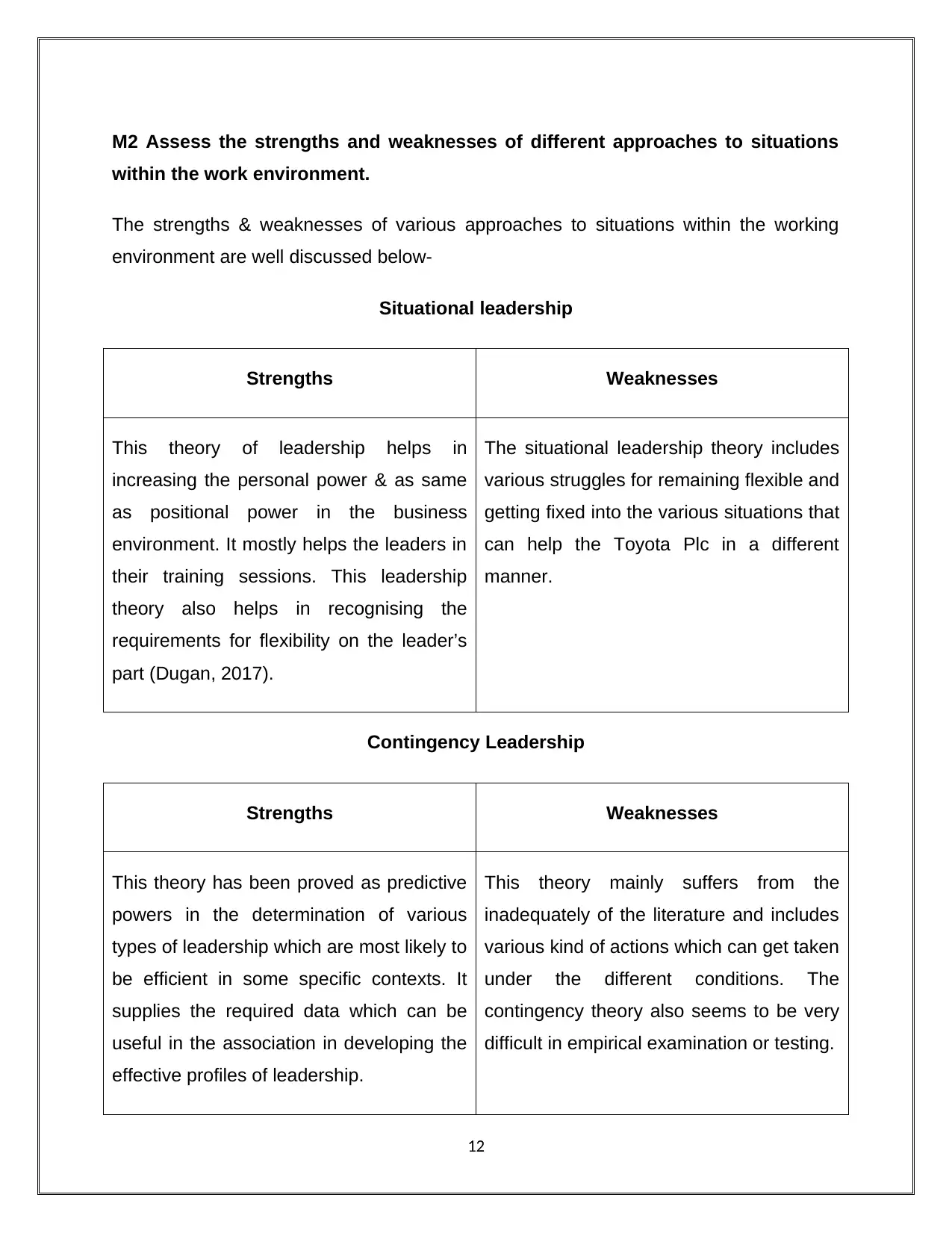
M2 Assess the strengths and weaknesses of different approaches to situations
within the work environment.
The strengths & weaknesses of various approaches to situations within the working
environment are well discussed below-
Situational leadership
Strengths Weaknesses
This theory of leadership helps in
increasing the personal power & as same
as positional power in the business
environment. It mostly helps the leaders in
their training sessions. This leadership
theory also helps in recognising the
requirements for flexibility on the leader’s
part (Dugan, 2017).
The situational leadership theory includes
various struggles for remaining flexible and
getting fixed into the various situations that
can help the Toyota Plc in a different
manner.
Contingency Leadership
Strengths Weaknesses
This theory has been proved as predictive
powers in the determination of various
types of leadership which are most likely to
be efficient in some specific contexts. It
supplies the required data which can be
useful in the association in developing the
effective profiles of leadership.
This theory mainly suffers from the
inadequately of the literature and includes
various kind of actions which can get taken
under the different conditions. The
contingency theory also seems to be very
difficult in empirical examination or testing.
12
within the work environment.
The strengths & weaknesses of various approaches to situations within the working
environment are well discussed below-
Situational leadership
Strengths Weaknesses
This theory of leadership helps in
increasing the personal power & as same
as positional power in the business
environment. It mostly helps the leaders in
their training sessions. This leadership
theory also helps in recognising the
requirements for flexibility on the leader’s
part (Dugan, 2017).
The situational leadership theory includes
various struggles for remaining flexible and
getting fixed into the various situations that
can help the Toyota Plc in a different
manner.
Contingency Leadership
Strengths Weaknesses
This theory has been proved as predictive
powers in the determination of various
types of leadership which are most likely to
be efficient in some specific contexts. It
supplies the required data which can be
useful in the association in developing the
effective profiles of leadership.
This theory mainly suffers from the
inadequately of the literature and includes
various kind of actions which can get taken
under the different conditions. The
contingency theory also seems to be very
difficult in empirical examination or testing.
12
⊘ This is a preview!⊘
Do you want full access?
Subscribe today to unlock all pages.

Trusted by 1+ million students worldwide
1 out of 29
Related Documents
Your All-in-One AI-Powered Toolkit for Academic Success.
+13062052269
info@desklib.com
Available 24*7 on WhatsApp / Email
![[object Object]](/_next/static/media/star-bottom.7253800d.svg)
Unlock your academic potential
Copyright © 2020–2025 A2Z Services. All Rights Reserved. Developed and managed by ZUCOL.





